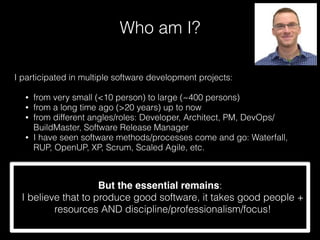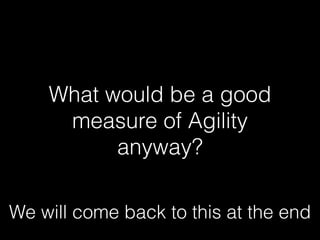Agility via Software Engineering Practices - Agile Tour Montreal 2015
- 1. Agility via Software Engineering Practices Agile Tour Montréal - November 2015 Steve Mercier
- 2. Who am I? I participated in multiple software development projects: • from very small (<10 person) to large (~400 persons) • from a long time ago (>20 years) up to now • from different angles/roles: Developer, Architect, PM, DevOps/ BuildMaster, Software Release Manager • I have seen software methods/processes come and go: Waterfall, RUP, OpenUP, XP, Scrum, Scaled Agile, etc. But the essential remains: I believe that to produce good software, it takes good people + resources AND discipline/professionalism/focus!
- 3. But enough about me
- 5. Are You Agile? Agile is not easy… and is not only about ceremonies + tools!
- 6. A few questions • Raise your hand, if you participate in: • Daily stand-up meetings • Sprint planning meetings • Sprint reviews and demos • Sprint retrospectives and lessons learned • Regular backlog grooming sessions
- 7. Now THE question • By raising your hand • Who believes that he/she works in an Agile environment?
- 8. What would be a good measure of Agility anyway? We will come back to this at the end
- 9. What is your (real) release frequency? • At what frequency are you delivering software updates that add value to your clients? • Once a year? • Once a quarter? • Once a month? • Once a sprint? • Once a day? Without breaking any previously delivered business value that you want to retain…?
- 10. Scrum Overview
- 11. Agile Simplified Overview How can we ensure this loop works smoothly and fast? Client PO Team Delivery
- 12. What are the typical Agile issues? Elements preventing Agility that could be fixed by a specific software development practice?
- 13. Agile Issue #1: Communication Issues
- 14. Dozens of ways to communicate With more and more possibilities, growing!
- 15. Communication Issue Example “But, I published my design document on SharePoint!”
- 16. Communication Issue Example “But, I sent you an email!”
- 17. Communication Issue Proposition Only one truly Agile communication technique: Dialog!
- 18. What technique can improve dialog? You could consider BDD to close the communication gap between business people and technical people
- 19. Agile Issue #2: Manual Interventions
- 20. Everything not automated reduces your Agility
- 21. Manual triggers can take a long time Manual = Time++;
- 22. As your manager might say Time == Money();
- 23. What techniques can reduce manual steps? You could consider using DevOps: CI server, CD server, Infrastructure as Code to automate as mush as possible your release process DevOps Client PO Team Delivery
- 24. What techniques can reduce manual steps? Continuous Integration
- 25. What techniques can reduce manual steps? Continuous Delivery/Deployment
- 26. What techniques can reduce manual steps? Infrastructure As Code
- 27. Agile Issue #3: Customers not really validating increments
- 28. Not fully involved customer…
- 29. Customer not validating increments Proposition You should again consider using BDD to involve your customers as much as possible; this would ensure a relationship between the needs and the demo • Various things could contribute to this issue (cumulative!): • Specifications created without customer’s involvement • Specifications not properly handed over to teams for execution • Specifications not validated automatically or systematically every sprint • Customers not involved in sprint demos or not giving feedback during demos • Not delivering produced software regularly to customers for evaluation
- 30. Remember, you want this
- 31. Not that!
- 32. Agile Issue #4: PO wants it all (aka priority management issue)
- 33. Be careful about scope creep and absence of prioritization!
- 34. PO wanting it all I do not really have a specific technique for this one… I suggest selecting the right PO in the first place AND then to use proper backlog grooming techniques (Buy him the book 50 quick ideas to improve your user stories by Gojko Adzic)
- 35. Agile Issue #5: Demos done from unreleased software (aka Works at my desk)
- 36. Your software must have it!
- 37. Demos from unreleased software / Difficulty to release in production Involve Ops people in sprints Releasing in prod should be doable by anyone, anytime, using a single click (rollback is obviously a feature you will want!)
- 38. Agile practices to overcome the presented Agile issues Intro to a few + associated tools
- 40. BDD—Behaviour Driven Development Bridges the gap between customers/business people and teams 1-An technology agnostic feature file developed with your users This is somehow an executable specification
- 41. 2-A technology specific code generator (SpecFlow/C#, JBehave/Java, Behave/Python, etc.) BDD—Behaviour Driven Development
- 42. 3-Complete cycle with inner TDD BDD—Behaviour Driven Development
- 44. Continuous Integration Continuous Builds, Continuous Testing, Continuous Inspections
- 45. Continuous Integration Not only build on commit by the continuous integration server, but also: • Systematic unit tests (e.g. NUnit, JUnit) • Aim at 70-90% code coverage • Measure your coverage (e.g. dotCover, NCover) • Code inspections (static analysis, linter, code complexity)
- 46. Continuous Integration cont’d: • Publish built artifacts on artifacts server (e.g. Artifactory) • Deploy into staging environments • Run integration/functional testing • Run performance testing • Publish reports of selected metrics for the above elements (e.g. SonarQube)
- 48. Continuous Delivery/Deployment Always have a shippable version available for your customers Ex: GO CD (from Thoughtworks - now Open Source) You can integrate your CI servers (Jenkins) with a CD server
- 49. Continuous Delivery/Deployment A good practice to deploy gradually using cascaded environments: • (Development) • Test • Less resources, used mostly to validate business logic • Staging/Pre-Production • More representative of the production environment. Can be used for load/performance testing. Typically uses a data set that is a copy of the Production data set. • Production
- 51. Infrastructure as Code Your code is under CM, but your infrastructure is typically not! It also needs to be versioned, tracked and automated!
- 52. There are so many tools available. But essentially, keep ALL under source control, including what it takes to reproduce your production environment from ZERO Infrastructure as Code • How to restart a hardware environment/virtual machines • How to install the platform on the machines • How to install the applications on the platforms • How to configure the whole stack • The databases schemas and content • Everything!
- 53. If you are not convinced, think about your disaster recovery plan (you have one, right?) Infrastructure as Code What if your server room is destroyed by water/ fire? (or the one from your cheap cloud provider…) With IaC at least, the software part is covered in case of disaster
- 54. DevOps
- 55. DevOps • A Good app without an infrastructure to run it is useless… • A superb, scalable infrastructure without an app adding business value to a customer is also useless… • You need both! • DevOps should not be a separate team! It serves to bridge the gap between development and operations teams. • And if you are not convinced that DevOps cannot typically be a single person’s responsibility…
- 57. Agile Values vs. Agile Practices
- 58. Agility is more than Agile values and ceremonies It is acting as per the Agile values and producing software with related best practices
- 59. But where to start? Every Agile cycle, try to improve on those issues, trying to automate everything you can, while having the conversation with your key stakeholders
- 60. What would be a good measure of Agility anyway?
- 61. Suggestion #1: The frequency at which you are delivering software updates that add business value to your clients without breaking any previously delivered business value that you want to retain (aka The capability to release)
- 62. Suggestion #2: The time it takes you to deliver the smallest change/fix to your software in production (aka The time to release)
- 63. Engineering requirements to attain Agility: Good people with good tools, applying proven software development best practices consistently with discipline using continuous improvement principles
- 64. Questions or comments? © Pyxis Technologies inc.
- 65. Thanks! © Pyxis Technologies inc.
- 66. Titre sur mesure POINTS FORTS 1 T h a n k&yo u ! Questions pyxis&tech.com


































































